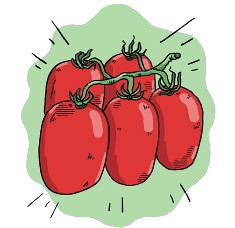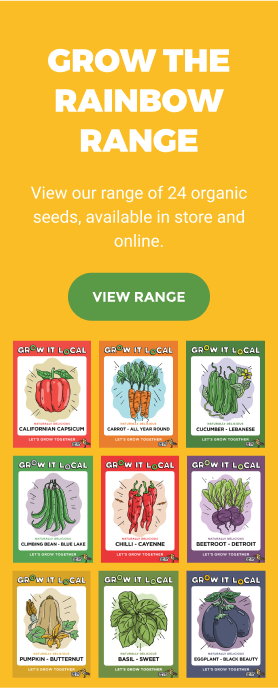How to grow Tomato Roma
Buy Seeds
How to grow
Join Our Community
Learn to grow and cook healthy, delicious, organic food at home by joining our seasonal grow-alongs.
Join Our Community
Learn to grow and cook healthy, delicious, organic food at home by joining our seasonal grow-alongs.
Background
Roma tomatoes, also known as Italian plum tomatoes or paste tomatoes, are a popular and distinctive variety of tomatoes with a rich history.
The name ‘Roma’ refers to the city of Rome in Italy, but the Roma wasn’t actually developed in Italy, The origin of the Roma tomato can actually be traced back to the early 20th century when they were first developed in the United States. They are believed to be a cross between San Marzano and an unknown variety of American tomatoes. The goal was to create a tomato with ideal characteristics for making sauces, pastes, and canned products due to their firm, meaty texture and low moisture content.
Tomatoes in general are native to the western regions of South America, particularly in present-day Peru and Ecuador. Ancient indigenous peoples, such as the Incas, were already cultivating and consuming wild tomato varieties as early as 500 BC.
During the 16th century, the Spanish brought tomato seeds from the Americas back to Europe. Initially, tomatoes were considered ornamental plants and were grown as curiosities in botanical gardens.
They bore little resemblance to the tommies that we grow today and were known as pomo d’oro, which translated to Golden Apple
Gradually, tomatoes gained popularity as a culinary ingredient in Italy, especially in the Naples region, where they became a staple in pizza and pasta sauces. Becoming a cornerstone of one of the world’s most popular cuisines.
Health Benefits
Homegrown, organic Roma tomatoes are good for you!
Tomatoes are an excellent source of vitamins (A, C, and K) and minerals (potassium).
Eating tomatoes can support healthy vision, immune function, and skin health due to their vitamin content.
The antioxidant lycopene, responsible for the vibrant red colour, helps protect against cellular damage and reduces the risk of certain cancers and heart disease. Tomatoes are also a good source of fibre, which promotes digestive health
Growing Tips and Tricks
Location:
Roma tomatoes thrive in warm climates with full sun exposure. Choose a location in your garden that receives at least 6-8 hours of direct sunlight daily. The soil should be well-draining, fertile, and rich in organic matter.
Watering:
Roma tomatoes require regular and consistent watering to develop healthy fruit. Keep the soil evenly moist but not waterlogged. In hot weather, you may need to water daily
Problems:
Pest Control: Watch out for common tomato pests such as aphids, whiteflies, and tomato hornworms.
Diseases: Roma tomatoes can be susceptible to diseases like early blight and blossom end rot. To prevent these issues, avoid overhead watering and provide good air circulation around the plants.
Blossom Drop: In extreme heat, Roma tomato plants may experience blossom drop, where the flowers fall off without setting fruit. If you live in a climate that experiences extreme summer heat, providing shade during the hottest part of the day can help prevent this problem.
Cracking: Rapid fluctuations in moisture levels can lead to cracking in Roma tomatoes. Maintain consistent soil moisture to prevent this issue.
Harvest:
Roma tomatoes are ready for harvest when they reach their mature size and have developed their characteristic deep red colour. The fruits should feel firm to the touch. Use a sharp pair of scissors or garden shears to cut the tomatoes from the vine, leaving a short stem attached.
Patch to plate
Growing sun ripened, juicy, sweet and tangy homegrown tomatoes is usually at the top of everyone’s gardening wish list. No store bought tomatoes can come close to the intensity of flavour and satisfaction that comes from growing and eating your own. Roma tomatoes can be used for all kinds of culinary adventures, here’s a couple of ideas to get you feeling inspired…
- Make your own delicious homemade pasta sauce
- Sliced and served with mozzarella and basil as part of a caprese salad
- Served with red onion, cucumber, cumin, coriander and herbs in an Indian inspired kachumber salad




